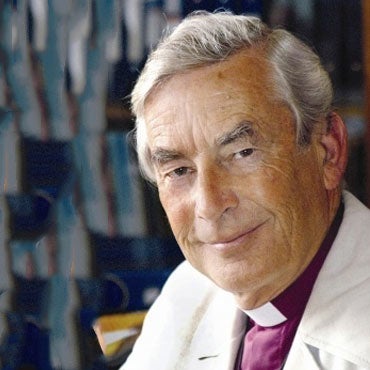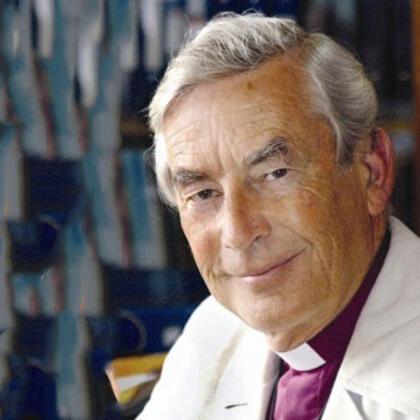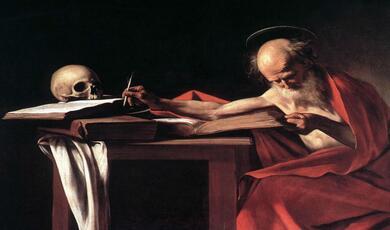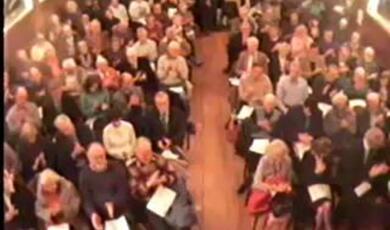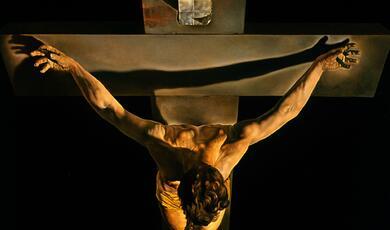Christian Themes in Art: Understanding faith through the eyes of Stanley Spencer
Share
- Details
- Text
- Audio
- Downloads
- Extra Reading
The reputation of Stanley Spencer continues to grow. All his life he painted Christian themes with his fresh and distinctive vision. For him art was the product not so much of talent as love, and this love enables us to see everything as it truly is, newly risen to life.
This is a part of the 2010/2011 series of Divinity lectures by Lord Harries. For other lectures in this series, please follow this link: Religion and Art
Download Text
Gresham Lecture, Wednesday 16 March 2011
Understanding faith through the eyes of Stanley Spencer
The Rt Revd Lord Harries of Pentregarth,
Gresham Professor of Divinity
Spencer (1891-1959) trained at the Slade at a time when drawing and clarity of line was emphasised. Cosy, secure childhood reflected in his paintings. Unhappy period when he became obsessed with Patricia Preece, divorced his wife Hilda, but then sought to reclaim her imaginatively in his pictures. Made his living by selling paintings of scenes round Cookham.
He saw beauty in unusual places. This beauty usually had a strong sensual element.
He also saw the Holy there, as in Sarah Tubb and the Heavenly visitors. Sarah Tubb saw Haley’s comet and taking it to be a sign of the end of the world knelt to pray.
Villagers and Saints, 1933, University of Hull Art Collection
In Cookham High Street the children play marbles or sprawl around. An old man looks at his bag of empty beer bottles. Interspersed between them are angels, also observing the marbles, or the beer bottles or just sitting around in the sun. Heaven is on earth and earth is taken up into heaven. Angels and men dancing together is a theme of Botticelli’s nativity. But here, as in so many of Stanley Spencer’s paintings, the earthly is earthly indeed. It is the ordinary, everyday, mundane aspects of life which for him radiated with the divine. Stanley once wrote
When I lived in Cookham I was disturbed by a feeling of everything being meaningless. Quite suddenly I became aware that everything was full of special meaning, and this made everything holy. The instinct of Moses to take his shoes off when he saw the burning bush was very similar to my feelings. I saw many burning bushes in Cookham. I observed the scared quality in the most unexpected quarters.
He painted Biblical scenes throughout his life, but again with a strong sensual element.
Christ Preaching at Cookham Regatta, 1959, Cookham
Here all is crowds and jollity. The man in the front is carrying mops and assorted boat gear, practical tasks to be done, which were always important to Stanley. Christ sits in a wicker chair on the ferry a little way off shore. Behind the ferry is a row of punts. It is a picture based on the scene in Mark Chapter 4 where it is recorded that the crowds were so great that Christ got into a boat where he sat and from which he talked. The crowd gathered at the water’s edge. Here Christ has bare feet, a long coat and hat, like a chasidim but sitting in a basket chair, leaning forward with such excitement that he has to hold himself in his chair to stop himself going forward. Children and little people are in the ferry. The scene took him back to his youth when literally thousands of people came down from London to join locals in the exuberance of the regatta. To Stanley the regatta was a symbol for the fulfillment of everyone’s wishes.
If it is carnal wishes, they will be fulfilled; if it is creative wishes, they will be fulfilled. If it is sexual desires or picture making inspiration that is to be satisfied, then Christ will heave the capstan round . . . all will be met. Everything will be fulfilled in the symbol of the regatta. The complete worshipfulness and loveableness of everything to do with love is meant in this regatta scene. In that marvelous atmosphere nothing can go wrong.
The children on the ferry are, he said “like little frogs which have jumped accidentally into punts from the riverbank”. We are reminded of the words of Jesus that we must become like little children and that the babes and sucklings cry out in praise.
Christ Carrying the Cross
This picture, painted in 1920 is in the Tate Gallery. The light seems to come from high up on the right as we look. The men on the bottom left are shielding their faces from it. The light casts strong shadows on the houses from the people. The light seems pale, almost unearthly. The sky is not bright blue, is it moonlight, or early morning light? The colours too are interesting with their subdued, pastel shades.The people are looking out of windows, the net curtains are blowing out rather like angels' wings as the people look all about. The presence of the ladders derives from what actually happened when Stanley Spencer was working on this composition. He saw workmen carrying ladders across the houses and this provided, as he put it "the reality of everyday life" and enabled him to locate the via crucis in Cookham high street. The ladders are a visual echo of the shape of the cross. Women with doll-like faces are by the railings, which are in the shape of sharp spears suggesting violence.Christ himself is hidden under the cross whilst men with caps, perhaps bricklayers with hods, and a slight sense of Klu Klux Klan menace. Overall there is a sense of people being out and about and busy, with the procession to the crucifixion hardly noticed, lost amidst ordinary, everyday things. Yet it is the light that indicates something strange taking place, perhaps it is one of those shafts of light that you get sometimes just before or after a storm.
The Tate Gallery originally mistitled this picture “Christ Bearing his Cross” which intensely irritated Stanley Spencer. As he said, the false title implied
A sense of suffering which was not my intention. I particularly wished to convey the relationship between the carpenters behind him carrying the ladders and Christ in front carrying the cross. Each doing their job of work and doing it just like workmen . . . Christ was not doing a job or his job, but the job.
Again, when Stanley Spencer’s dealer thought of cataloguing the painting as “Christ Carrying His Cross” Stanley was furious. The cross was for him universal. We all have to carry the cross.
The Crucifixion
This was the last major painting by Stanley Spencer before his death in 1959. It was painted for the chapel of a school funded by brewers, hence the brewers cap on the men nailing Christ to the cross. The painting caused a public outcry and when Stanley Spencer went down to talk to the school about the meaning of the painting his remarks would hardly have helped. He told the boys "It is your governors and you who are still nailing Christ to the cross".In this painting we stand as spectators on a pile of rubbish in Cookham high street, with other spectators looking out of their windows. Mary is spread-eagled on the ground as though thrown by a wave. A schoolboy ties the legs and there is a grotesque abuse from one thief. The brewers men are using all the force they can muster to bang home the nails. Storm clouds gather above and Christ looks up, accepting of his fate.
The Resurrection, 1924-26, The Tate GalleryResurrection was a theme which preoccupied Stanley. It is not only this famous Resurrection in Cookham in Churchyard and The Resurrection of Soldiers in the Sandham Memorial Chapel but the Port Glasgow Resurrections and the Resurrection Reunion now at Aberdeen. Everything in this picture has personal significance. Stanley is lying on the tomb at the bottom right. Hilda is shown a number of times, each representing a luminous moment, a sudden flash of awareness which lifted his spirit in joy. As Stanley himself wrote “No-one is in any hurry in this painting. Here and there things slowly move off, but in the main they resurrect to such a state of joy that they are content and happy to remain where they have resurrected. In this life we experience a kind of resurrection when we arrive at a state of awareness, a state of being in love . . . and at such time we like to do again what we have done so many times in the past . . . Hilda mooches along and slowly goes over a stile. She wears a favourite dress of hers. The people read their own headstones. By the ivy-covered church tower a wife brushes the earth and grass off her husband. Another buttons a man’s coat up and another straightens a man’s collar. Further down you see Hilda smelling of flowers . . . in each part of the picture the meaning of the resurrection is conveyed by bringing people into contact with their customary surroundings. To emphasise the place and bare fact of myself, I have thought of an open book . . . and when you read a book you settle down to it . . . and this me settling down between the two lids of the tomb is my signature to the painting.”
It is all about the “fresh realisation of the possibilities of heaven in this life”.
World War I
After a long period of agonizing he joined the RAMC serving first as a hospital orderly, then in Macedonia and then with the Royal Berkshires. This is reflected in a painting he did for the War Artists Commission, Travoys arriving at a Dressing Station at Smol, Macedonia, but especially in the Sandham Memorial Chapel. There he depicts, in fact celebrates, the ordinary activities of soldiers and also scenes in the hospital. Unlike the well known poets of this period he did not concentrate on the suffering but on the joy that can be found in the down to earth details of everyday living
The Crucifixion, 1921, AberdeenThis picture was commissioned for a village hall war memorial which eventually fell through. It depicts Macedonian topography and Mediterranean clarity of light. The composition is scattered, with a soldier on the left with spear and robe which he has won in the lottery. On the right at the bottom is the Centurion. Middle right are the spectators shaking their heads. The force of this imagery lies in his experience in the Vardar hills in Macedonia in 1918. He saw three ravines standing out in the snow “like three spear wounds”. They did not make him think of the crucifixion. Nor did he simply use the imagery in an illustrative way. His experience was both of the worst that lay ahead and yet great hope. As he walked along “I suddenly had a feeling of the completeness and fitness and ultimate redemption of everything . . . I felt I was a walking altar of praise”.The worst experiences which lay ahead are expressed in the distorted composition, very different from a camera view of the plain. The picture could also of course be given a Freudian interpretation. But Stanley was aware of this. As he wrote honestly and therefore revealingly
I start off in the direction of vision and am drawn towards secular wishes and desires. In expressing them, I come across a religious feeling as if by accident and not ready for it; I am unable to express it as it should be expressed and realised. Conversely, if I start off in the same vision way . . . trying literally to find this real religious something, I achieve ordinary uninspired secular feelings like in landscapes. The element I want in the religious picture I find in secular and in secular love and feeling; and the secular element I don’t like or want I find when I do a religious picture that is minus the sex element.
The Resurrection of Soldiers, painted between 1927 and 1932, Sandham Memorial Chapel
The Sandham Memorial Chapel was commissioned by Mr and Mrs Behrend in memory of their son who died in Macedonia. It is reminiscent of the Arena Chapel in Padua by Giotto. There are however major differences. The central Christ has been replaced by two resurrecting mules turning their heads, perhaps reminiscent of childhood memories of horses in the Vale of Health in Hampstead. Christ is not there as judge but as compassionate receiver of the soldiers’ crosses. In the memorial chapel at Burghclere, based on his experiences as a wartime hospital orderly, we have scenes of scrubbing floors, serving tea, making beds and washing furniture. Each activity is evoked in a way which is at once affectionate and affirmative. In this resurrection Kenneth Pople maintains that the soldier on the right lower side polishing brasses corresponds to Giotto’s depiction of hell at the same place. But there is no place for hell in Spencer’s scheme of things. Furthermore, ordinary physical tasks, however mundane, were for him part of the glory of things, provided their spiritual meaning can be discerned. As he put it, referring to his time in the hospital “I did not despise any job I was set to do, and did not mind doing anything so long as I could recognise in it some sort of integral connection with the spiritual meaning that demanded to be clarified”. He was much influenced in his attitude to work by some words of St Augustine about God being always at work and always at rest, which he thought of as God always fetching and carrying but with an inner serenity.In this picture the driver wakes between two mules, a scene perhaps based upon Stanley waking after the nightmares and taken to sleep between his parents. A little Christ is receiving the crosses of the soldiers. Below him a small Stanley gazes at a cross flattened wagon.
World War II
Spencer went as a War artist to Port Glasgow on the Clyde, 15 miles down river from Glasgow itself. He was fascinated by the communal life of the city. “ I liked it here being lost in the jungle of human beings, a rabbit in a vast rabbit warren.” Also, the process of production. “I was as disinclined to disturb them as I would disturb a service in church”. Did preliminary sketches on a roll of toilet paper, “The roll”. These fabulous paitings of shipbuilders at work finished off in studio in Epsom. Well received in London and New York. (Three restored ones can be seen this summer in the Stanley Spencer Gallery in Cookham)
Christ in the Wilderness Series
Some of the painting in this series painted in 1939/40, a time of great personal unhappiness when he lived on his own in Swiss Cottage. But it was also a time of great spiritual awareness. “I felt there was something wonderful in the life I was living. I loved it all because it was God and me all the time.” These great paintings now in the Gallery of Western Australia in Perth.
The Port Glasgow Resurrection Series
After describing the vivid life of the city he wrote that it
Seemed to me full of some inward surging meaning, a kind of joy, that I longed to get closer to and understand to in some way fulfil; and I felt that all this life and meaning was somehow grouped round and in some way led up to the cemetery on the hill outside the town…and I began to see the Post Glasgow Resurrection that I have drawn and painted in the last five years.
I seemed to see that it rose in the midst of a great place and that all in the plain were resurrecting and moving towards it…I knew that the resurrection would be directed from the hill.
The Hill of Zion
As it has worked out this hillside cemetery has become The Hill of Sion where Christ seated in the top centre, directs the prophets, angels and disciples at the resurrection. Among the lilac here is a standing prophet scanning the country and by him a trumpeting angel; a recording angel with a scroll is above and a second trumpeting angel on the other side; one of the disciples squats and hugs his ankles. Beyond the left slope of the hill some girls lead a chain of children climbing from the plain, and beyond on the right side there are resurrected men and women
Tidying
In several of these paintings I have wanted to suggest an idea of different kind of “looking”-the steadfast look of the grandparents in the big picture for example; and here I wanted to give the difference between the daughter on the right who looks with affection and devotion at her father and the kind of peeping round the head-stone of the child and mother and the conversational look of the man and woman at the top on the left who are just talking sympathetically; and in the centre I wanted to make the contrast between the nurse-maid woman looking into the right-hand world and away of the import of all she sees, and the look of the child she carries who is turned to the left and looks at what he sees with wonder.
Winston Churchill “If this is the resurrection give me eternal sleep”. Spencer The contemplation of resurrection brings out what I love in ordinary life and vica versa.
Rejoicing
Grave tenders to right and mourners to left have a vision of the children rejoicing and singing-it is a real part of the resurrection but they see it as a vision.
In the foreground a woman waters flowers on a grave, another kneeling, holds a vase of flowers, and a third cuts the grass round the grave with scissors( a nice homely woman who once looked after me used to say “I’ve just been down to the churchyard and given me mother another a clip round” and she did it just so with scissors.
Reunion
Here I had the feeling that each grave forms a part of a person’s home just as their front gardens do, so that a row of graves and a row of cottage gardens have much the same meaning for me. Also although the people are adult or any age, I think of them in cribs or prams on mangers. “Grown ups in prams” would perhaps express what I was after-the sense of security and peace that a babe has as sit gazes over the rim of its pram out into the world around it.
All things are redeemable and I pain them in their redeemed state.
The intensity of Stanley Spencer’s feelings can be gauged by a remark he once made, perhaps about his friends the Slessors.
I remember having some friends I was always meeting in the evenings and did not see anything special about them until one day I went to have breakfast with them, and seeing them at breakfast gave me wonderful feelings about them. I was so overcome that I could not eat my breakfast, not even bread and butter.
For Stanley Spencer this feeling was above all that of love about which he once saidLove is the essential power in the creation of art and love is not a talent. Love reveals and more accurately describes the nature and meaning of things than any mere lecture on technique can do. And it establishes once and for all time the final and perfect identity of every created thing.
This love not only establishes the identity of every created thing but raises that thing into a harmonious relationship with all other things and people. If we believe with Thomas Aquinas that grace does not destroy but fulfill nature then in Stanley Spencer’s paintings we see grace at work on our disfigured world, transforming human relationships into a holy communion of the divine and the human, the divine expressed in and through the human, the spiritual in and through the physical, the holy in and through the mundane, the beautiful in and through what sometimes strikes us in his pictures as the ungainly or ugly. For all was embraced in his vision and raised into a heaven of here and now.
For those who want to see Spencer’s paintings two places not to be missed are the Stanley Spencer Gallery in Cookham and the Sandham Memorial Chapel, at Burghclere, just South of Newbury. (Daylight hours only, no electric light)
Relevant to this series of lectures people might be interested in two of my books
The Passion in Art, Ashgate
Art and the Beauty of God, Mowbray
©The Rt Revd Lord Harries, Gresham College 2011
Part of:
This event was on Wed, 16 Mar 2011
Support Gresham
Gresham College has offered an outstanding education to the public free of charge for over 400 years. Today, Gresham College plays an important role in fostering a love of learning and a greater understanding of ourselves and the world around us. Your donation will help to widen our reach and to broaden our audience, allowing more people to benefit from a high-quality education from some of the brightest minds.


 Login
Login
